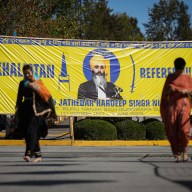Lou Diamond Phillips is dedicated. Like his fellow stars in “The 33” — the film about the 2010 Chilean mining accident, where 33 miners spent 69 days trapped miles below the surface — he spent most of his days shooting in an actual mine. That gave him plenty of opportunities to learn what it was really like for his character, Luis Urzua, aka “Don Lucho,” the foreman who had warned his bosses about the deplorable conditions and unmet regulations, then was racked with guilt after the mine really did collapse. Have you ever read George Orwell’s “The Road to Wigan Pier”? It has lengthy, detailed descriptions of the conditions inside English mines in the 1930s that will give you nightmares, although conditions have dramatically improved, even with the Chilean mine that collapsed. I haven’t read it. But when this film began I had just started reading Ken Follett’s Century trilogy, and the first book starts in a Welsh mine. There I was, down in Colombia, thinking, “Maybe this isn’t what I should be reading right now.” It was talking about a mine collapse and the hardships of going down into a Welsh mine. But I looked at it as kismet — one of those fringe benefits of getting into the proper mindset. RELATED: Antonio Banderas on what it’s like to shoot in a real mine for “The 33” Don Lucho is the essentially smartest guy in the room, though in this case it also means he’s the one pointing out, initially, how little hope they have for escape.
It was a fine line for me to walk, because I could come off as simply the naysayer or the foil to Mario Sepulveda [played by Antonio Banderas] and his overflowing optimism and blind faith. But where Don Lucho was going from was pragmatism and realism. He knew the odds of rescue, and he knew what had happened, time and time again, when mines had collapsed. His overwhelming guilt about not being able to effect change in the mine before the collapse, despite his considerable efforts, is what comes across most in the film.
He took it all very personally. You have to understand this is a small community. Even though Don Lucho was the boss, these men were his friends. They ate together, they raised their families together. He had a huge sense of responsibility, in addition to the pride he took in his work. I wanted to capture that responsibility and that guilt he directed at himself. I remember when I first read the script, I thought to play him as simply the villain or the conduit through which we see Sepulveda’s heroism would have been reductive, simplistic. I’ve played a lot of heroes in my time, and heroes, I’m sorry, but they tend to be very one-note. They tend to be simple. And Lucho is incredibly complex. I thought, “How can I portray a man who willingly gives up his leadership without making him look pathetic?” There’s this growing desperation to him. He tries to get his s— together after the collapse, but at every juncture he’s foiled: the radio doesn’t work, the chimney ladders are not complete, the ramp is blocked. Time and time again the things he had raised awareness of were not in place. He was not given the tools to properly do his job. This film has uncommon access to those involved. How much did you rely on meeting the real Don Lucho? Meeting him was instrumental, but I didn’t meet him till we had been filing for two or three weeks. So I had to go on instinct. I had to go on choices based upon what was in the script and what I found in rehearsals. I was incredibly relieved when I met the man, and thought I was on the right track. I had even decided before that to have a more grounded movement — that Don Lucho not only had the weight of his position, but had spent his entire life in mines. I thought he was a man who has had a ton of rock over his head for the majority of his life. That has to weigh down on you. That has to make you feel part of the earth. I tried to adopt that physical sense of myself. When I met the real Don Lucho, I was like, “There it is.” They also made a lot of videos, once they were able to get cameras down there. Was he often in those?
There was actual footage from when Mario was doing guided tours for the video camera they sent down. You would almost always catch Don Lucho looking at blueprints, at the map. He was constantly, in an intellectual, cerebral way, trying to find a way out. RELATED: Anthony Mackie on homelessness and that pro-Trump misquote It can’t be easy acting in a real mine.
It made all the sense to me, and it seems to be flabbergasting to a number of people. First of all, it was an independent film. We didn’t have $100 million to build three soundstages worth of mines. It was more economically feasible to go into the real deal. Even artistically it leant a real veracity to the proceedings, to our mindset as actors. It obviously presented a number of problems: you have to drag all the lighting, all the camera gear down this mine, plus a 60 to 70 person crew, plus 30 or so actors. It was a logistical nightmare. I think that amount of commitment, that amount of focus is self-evident in the scenes in the mine. How does one get over acting inside a mine when you’re wrap each day?
You don’t. You don’t get over it. People are used to thinking of movie stars walking away from the set and going into their massive, double pop-out trailer and going to their four-star hotel at night. This was not the case. We did not have trailers; we had storage units with a cot in it — which we didn’t see all day, because once you went into the mine that was it. You came out at lunch and then you went back in. That’s 12 to 14 hours a day. And we were staying in a truck-stop motel. That was the best they had to offer — no offense. This was a total immersion into the lifestyle of who we were playing. There was no respite from the commitment to this role. It was method acting.
100 percent. It was enforced method acting.
Lou Diamond Phillips on being more than the nasayer in ‘The 33’
Follow Matt Prigge on Twitter @mattprigge


















